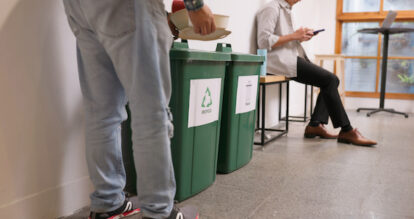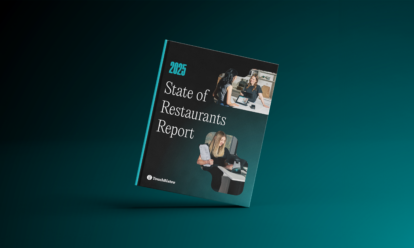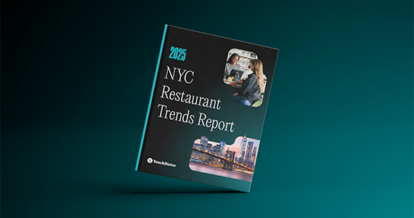While some restaurants have succeeded in creating a zero-waste environment, surplus waste is inevitable for most food service businesses. However, failing to invest in restaurant recycling can significantly increase the volume of waste that you produce, damaging not just the planet, but also the sustainability of your bottom line.
According to the food waste nonprofit ReFed, the U.S. food services industry generated 12.8 million tons of food waste in 2021 alone. This amounts to $139 billion spent on surplus food. If that’s not worrying enough, almost 80% of this food waste goes straight to landfill.
When food waste ends up in the landfill, it rots and releases methane – a greenhouse gas with more potency than carbon dioxide – into the environment. This is why reducing restaurant food waste is one of the biggest priorities for sustainability focused restaurants.
But it’s not just food. Styrofoam containers and single-use plastic cups, straws, lids, utensils, and sauce packets are all wasteful resources that restaurants generate daily.
This article will discuss how restaurant recycling can drive significant cost benefits while reducing your carbon footprint. We’ll also throw in some tips to help you execute a successful recycling strategy.
But first, let’s break down which materials are recyclable and how they should be stored.
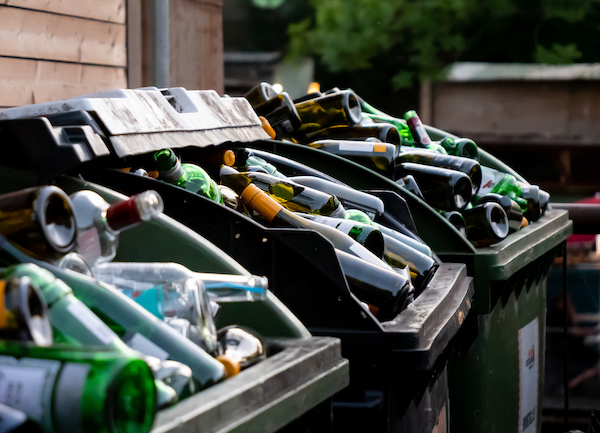
What Materials Can Your Restaurant Recycle?
Your municipality decides your recycling options, including which materials can and cannot be recycled. Some of the most accepted recyclables include aluminum, steel, paper, plastics, and cardboard. Crucially, you can also recycle food waste.
What About Restaurant Grease Recycling?
Fat, oil, and grease are staples in almost every restaurant kitchen. But what do you do with the vats of burnt oil once you’ve finished sizzling your fries to perfection?
Whatever you do, refrain from pouring leftover grease down your drain.
While hot grease is the right consistency for pouring down the drain, grease solidifies as soon as it cools. This results in a buildup of solidified grease that will clog and damage your restaurant’s pipes, causing major plumbing issues.
At worst, it can cause hazardous sewer blockages and cause sewer waste to back up into your restaurant.
To eliminate this risk, dispose of old grease in a dedicated, on-site grease dumpster. To prevent the grease from leaking, schedule regular pickups with a cooking oil collection company for restaurant grease recycling. This way, your grease can be picked up and recycled into biofuels and animal feed.
How Should Trash and Recyclables be Stored?
To better organize your restaurant’s waste disposal process, it’s important to understand how trash and recyclables should be stored. Trash and recyclables must always be sorted and stored appropriately before being picked up by waste disposal or recycling services.
Some top tips for waste storage and management on both a pre-consumer and post-consumer level include:
- Preventing non-recyclable items from making it into the recycling bin (and vice versa). Include clear signage on your restaurant bins detailing what can and cannot be put inside them. Food accounts for 22% of municipal landfill waste in the U.S. – a volume that could be reduced with better bin and collection systems.
- Rinsing out recyclable materials before putting them in a bin. This prevents your recycling batch from being spoiled by food particles.
- Flattening cardboard boxes to save space. Invest in an aerated bin to hold food waste that can be recycled into compost.
The Cost-Saving Benefits of Restaurant Recycling
Aside from the environmental impact, implementing a recycling program can also help to reduce business costs in various ways. Let’s explore some of the most crucial benefits.
Reduces Restaurant Operational Costs
Recycling programs focus on all areas of resource sustainability. As such, a key part to recycling is to also reduce the amount of waste you produce by reusing products. This will, in turn, reduce operational costs.
Look to reduce the number of one-time materials and products you use by seeing which can be replaced by a reusable alternative. For example, you can replace paper towels or napkins with washable fabric cloths. Although the up-front cost might be higher, in the long term, you’ll save money by being able to reuse these products.
More generally, investigate where materials are being wasted unnecessarily. For example, point-of-sale (POS) order errors also generate significant waste and business costs in lost productivity and produce. With the help of an all-in-one restaurant management system and intuitive mobile POS, you can streamline menu management and minimize order errors.
Reduces Purchasing Costs
The goal of recycling is to reduce your overall waste. This includes reducing the amount that your restaurant is over-purchasing. If you make sure you’re purchasing the right amount of perishable products, you will reduce the amount you need to recycle (and the related waste management costs) and reduce your purchasing costs at the same time.
What this means in practice is good inventory management by monitoring fresh produce usage and waste. If you know what sells and what rots, you can determine how much produce should be ordered and minimize the amount you need to recycle.
To do this, enlist the help of enterprise resource planning.
An enterprise resource planning (ERP) platform streamlines inventory management by integrating with the rest of your tools and operations, such as your restaurant management tools, accounting software, and sales systems.
With increased insight into your data from all angles, you can reduce over-purchasing by aligning decisions with your stock, budget, CRM, and sales data. This mitigates the risk of being left with hoards of perishable produce that you can’t shift – which leads us to our next point…
Lowers Disposal Costs
General restaurant waste disposal is considerably more expensive than restaurant recycling services. High volumes of waste result in more frequent trash pickups and higher hauling costs.
Switching to recyclable and reusable materials can free up valuable space in your trash can. The less waste you generate, the less you’ll need to spend on restaurant waste disposal services. And with recycling services being cheaper, you want as much of your waste management costs directed towards it as possible.
How to Make Recycling Cost-Effective
As explained above, restaurant management and ERP make recycling more cost-effective by enabling better purchasing decisions. They give you hyper-accurate insight into your historical inventory, current inventory, and sales to drive better financial decisions, reducing purchasing costs and your volumes of waste.
But, as we also mentioned, food surplus is inevitable in the food industry. It’s a common belief that around 4-10% of food is wasted before it even reaches the consumers’ plate.
Luckily, you can maximize the cost-effectiveness of surplus perishable stock by using every part of your ingredients to their fullest. Throwing away meat trimmings, vegetable stalks, and fruit stalks is financially and environmentally wasteful. Instead, use stalks to make seasonings, sauces, and garnishes.
You can do the same with meat trimmings and scraps, too – they’re perfect for creating cost-effective stocks, gravies, and drippings.
Another financially efficient practice is to prioritize using perishable items. Chances are your kitchen already follows the FIFO (First In, First Out) method. Even so, some items may be nearing their sell-by date. Rather than letting them spoil on the shelf, why not develop new, exciting menu items with them?
5 Tips for More Effective Restaurant Recycling
So, now you know the cost benefits of waste reduction and using restaurant recycling services. But without the right practices in place, even the best intentions can fail. Here are five tips to help you get your recycling program up and running.
1. Conduct a Waste Audit
A waste audit examines and analyzes your business’s current waste stream. It involves collecting data about your regular waste practices. Most notably, it verifies the volume and types of waste being thrown away within a given timeframe.
Establish a baseline for the volume of trash and recyclables your company generates every day for a week. As a best practice, conduct this audit during a typical business week (as opposed to a particularly busy one) to get an accurate average of your waste stream.
Effective ERP implementation software is invaluable to your auditing process. It centralizes data to provide you with an end-to-end view of your waste stream. This foundational data can be integrated with financial and sales data to drive the creation of recycling and reduction goals.
For example, a waste audit might highlight that your restaurant is generating a lot of post-consumer food waste. By identifying this problem area in your waste stream, you can devise targeted strategies to drive improvements – for example, adjusting portion sizes or composting more of your food waste.
2. Get the Right Restaurant Bins
The bins you use are critical to the success of your restaurant recycling initiatives.
It should be immediately clear to your employees and customers which bins are which. Each bin should be a different color and have signage that indicates what should go inside.
For example, if you have separate restaurant bins for food, plastic, and glass, label them with clear indicators, such as text and an accompanying image. This prevents waste from being misplaced accidentally.
3. Set up a Collection System
Don’t underestimate the importance of where you place your bins. If it’s more convenient for people to use the trash can instead of the recycling bin, you’re going to end up with a lot of misplaced waste.
An organized collection system avoids this issue. Make it easy for your employees and customers to make positive recycling decisions by strategically placing recycling bins in high-traffic areas and sections of your restaurant that generate lots of waste.
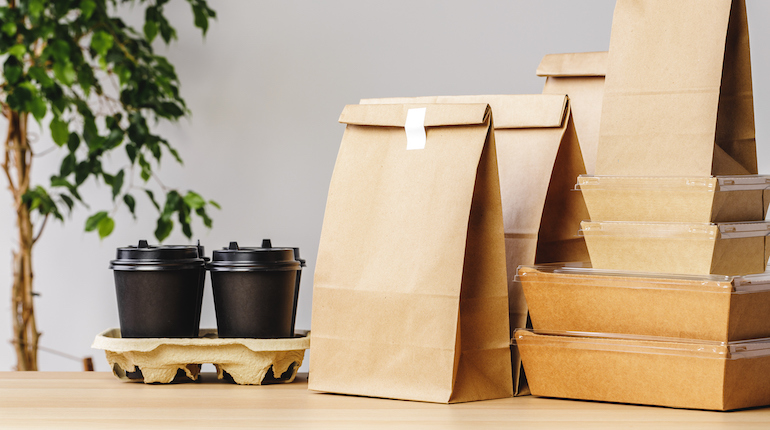
4. Swap Disposable Takeout Containers for Recyclable Packaging
Instead of disposable Styrofoam containers and single-use plastic bags, package your customers’ takeout in recyclable packaging. Swap plastic bags for paper bags and use aluminum, paper, or cardboard containers as an eco-friendly alternative.
5. Educate Your Employees
A successful restaurant recycling program isn’t possible without committed employees. But it isn’t enough to just tell them what your new recycling procedures are either – you must show them why they’re so vital.
Education is key to creating a culture of sustainability and improving employee retention. Provide employee training that details why you’re making waste management improvements, and how these initiatives affect the sustainability of your restaurant and wider community. Encourage them to identify areas for improvement and embrace suggestions they bring forward.
Enjoy the Benefits of Restaurant Recycling
From reducing carbon emissions to protecting ecosystems and wildlife, the widespread environmental benefits of recycling will always be invaluable. But a restaurant recycling program offers benefits on a business level, too.
Adopting recycling practices can significantly reduce the costs generated by waste. So, conduct a waste audit to identify areas for improvement in your restaurant. Whether you start dabbling in food composting or minimize waste through stricter inventory management, why not take your first step today?
Download our free inventory template
Sign up for our free weekly TouchBistro Newsletter

